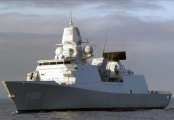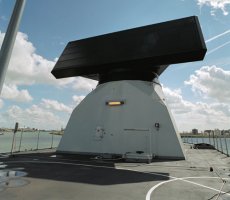SMART-L Radar
Description of the radar set, tactical-technical characteristics
| Specifications | |
|---|---|
| frequency: | lower D-Band |
| pulse repetition time (PRT): | |
| pulse repetition frequency (PRF): | |
| pulsewidth (τ): | |
| receive time: | |
| dead time: | |
| peak power: | |
| average power: | |
| instrumented range: | 250 NM |
| range resolution: | |
| accuracy: | |
| beamwidth: | 2.2 degrees |
| hits per scan: | |
| antenna rotation: | 12 rpm. |
| MTBCF: | |
| MTTR: | |
SMART-L Radar
Manufacturer: Thales Naval Nederland
(former: Hollandse Signaalapparaten BV
SIGNAAL)
SMART-L (Signaal Multibeam Acquisition Radar for Targeting) is the D-Band (former L-Band) long-range surveillance radarversion of the successful family of SMART multibeam 3D radars. It is designed according to NATO specifications for a Volume Search Radar. Designed to fulfil:
- Medium range detection of the newest generation of small “stealth” air targets
- Long range detection of conventional aircraft
- High ECCM performance
- Guidance support for patrol aircraft
- Surface surveillance
Due to its larger power budget, SMART-L is dedicated for the early detection and tracking of very small aircraft and missiles. The accurate 3D target information, gathered by the SMART-L radar, provides an essential contribution to the threat evaluation process, especially in multiple attack scenarios and it allows the weapon control system to perform the fastest lock-on.
The phased array antenna consists of a stack of 24 linear arrays. All 24 arrays are used during reception while 16 arrays are used during transmission. By controlling the phase of the RF energy, connected to the 16 elements, the illumination pattern can be controlled and level stabilized. The received radar energy is processed by 24 receiver channels and fed to a beamforming network in which 14 beams are formed in the elevation coverage from 0 to 70°. The output signals of the beam-former are further processed by a Doppler processor for the extraction of the target Doppler speed for clutter rejection and fast but reliable track initiation and maintenance of up to 1000 air targets. Clutter map and jamming map allow the detection and tracking of tangential flying targets and jammers. Surface surveillance is performed by an D-Band surface surveillance channel capable of automatic detection and tracking of up to 100 surface targets. Tracking data is transferred to the command and control system and high quality plot data to a MFR or MTTR.
Main characteristics
- Fully automatic detection, track initiation and tracking in 3D for air targets
- Mission selectable illumination patterns including a burn through pattern
- Fast reaction mode for the initiation of cued search by MFR or MTTR
- Low antenna side lobes in azimuth and elevation inclusive adaptive nulling against side lobe and main lobe jamming
- Automatic least jammed frequency and deceptive waveform operation
- Integrated surface surveillance
- solid-state transmitter
- Electronic stabilization
- Automatically functioning built-in test facilities (BITE).

Figure 2: Royal Netherlands Navy Air Defence and Command Frigate “De Zeven Provinciën” fitted with SMART-L and APAR

